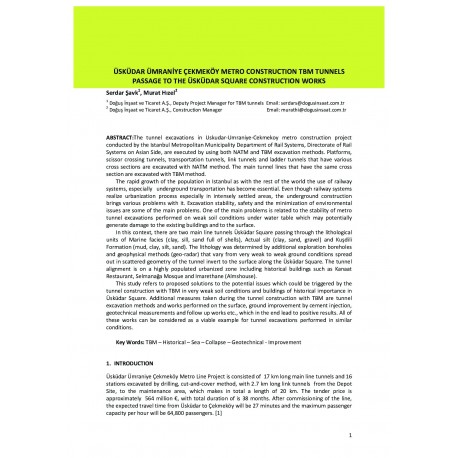Cart
0
0
No document
0,00 €
Total
Document successfully added to your shopping cart
Quantity
Total
There are 0 items in your cart.
There is 1 item in your cart.
Total documents
Total shipping
To be determined
Total
Search & filter
Search for a publication
Search & filter
Üsküdar ümranİye çekmeköy metro construction tbm tunnels passage to the üsküdar square construction works
1704_uskudar_umraniye_cekmekoy_m
The tunnel excavations in Uskudar-Umraniye-Cekmekoy metro construction project conducted by the Istanbul Metropolitan Municipality Department of Rail Systems, Directorate of Rail Systems on Asian Side, are executed by using both NATM and TBM excavation methods. Platforms, scissor crossing tunnels, transportation tunnels, link tunnels and ladder tunnels that have various cross sections are excavated with NATM method. The main tunnel lines that have the same cross section are excavated with TBM method. The rapid growth of the population in Istanbul as with the rest of the world the use of railway systems, especially underground transportation has become essential. Even though railway systems realize urbanization process especially in intensely settled areas, the underground construction brings various problems with it. Excavation stability, safety and the minimization of environmental issues are some of the main problems. One of the main problems is related to the stability of metro tunnel excavations performed on weak soil conditions under water table which may potentially generate damage to the existing buildings and to the surface. In this context, there are two main line tunnels Üsküdar Square passing through the lithological units of Marine facies (clay, sill, sand full of shells), Actual silt (clay, sand, gravel) and Kuşdili Formation (mud, clay, silt, sand). The lithology was determined by additional exploration boreholes and geophysical methods (geo-radar) that vary from very weak to weak ground conditions spread out in scattered geometry of the tunnel invert to the surface along the Üsküdar Square. The tunnel alignment is on a highly populated urbanized zone including historical buildings such as Kanaat Restaurant, Selmanağa Mosque and Imarethane (Almshouse). This study refers to proposed solutions to the potential issues which could be triggered by the tunnel construction with TBM in very weak soil conditions and buildings of historical importance in Üsküdar Square. Additional measures taken during the tunnel construction with TBM are tunnel excavation methods and works performed on the surface, ground improvement by cement injection, geotechnical measurements and follow up works etc., which in the end lead to positive results. All of these works can be considered as a viable example for tunnel excavations performed in similar conditions.




